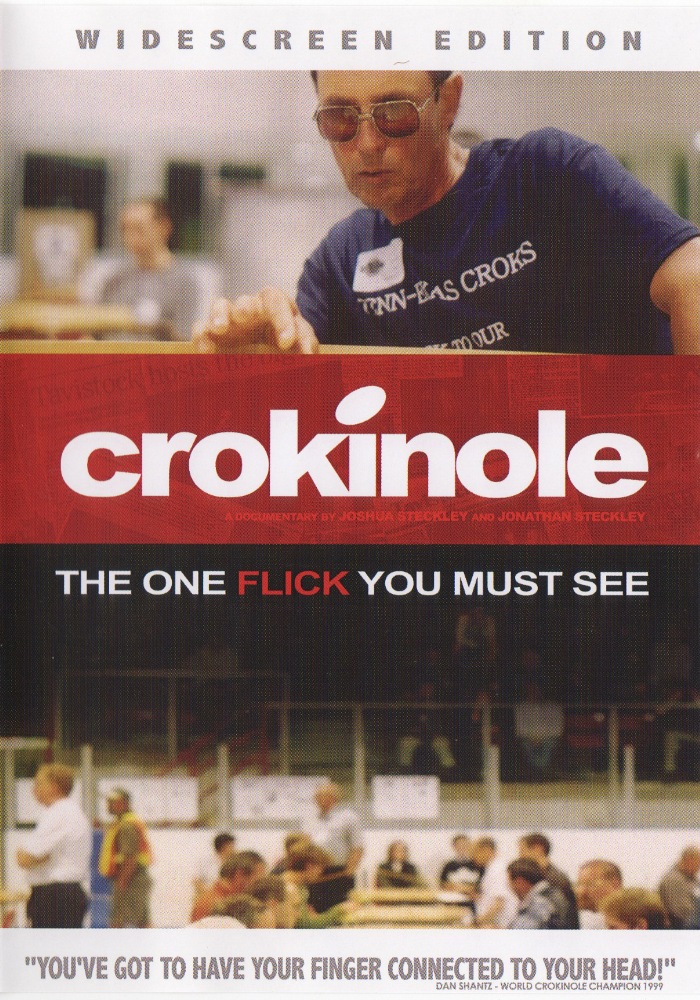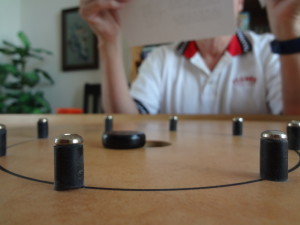Crokinole – The One Flick You Must See
If you’re familiar with the game of crokinole, then odds are that you’re either a hardcore board gamer or a grey-haired white guy from rural Canada as the documentary Crokinole reveals. The epicenter of the crokinole world would seem to be Tavistock, Canada, and it’s there that much of the 2006 documentary takes place, at the 2004 World Crokinole Championship. But what is crokinole? Crokinole is a board game that involves flicking wooden discs towards the center of a round board and knocking your opponents’ discs out into a gutter akin to shuffleboard or its indoor version, table shuffleboard, occasionally encountered at bars in America. It’s a pleasant enough game, involving skill and coordination, and can be quite satisfying, especially when a 20 is scored, the game’s equivalent to a bullseye. Crokinole is also a rather obscure game, with the game’s name unknown to modern computer spell checkers and college-educated professionals alike, so for it to be the subject of a documentary is fascinating in its own right.
Once you’ve understood the basic flicking mechanic of crokinole, the claims of the documentary to be “THE ONE FLICK YOU MUST SEE” will make more sense and seem a good deal less boastful. Crokinole opens by quoting from the 1897 Selected Journals of L.M. Montgomery:
We went over to the party but I can’t say I really enjoyed myself. Alf doesn’t dance – thinks it the unpardonable sin, I believe – and I didn’t like to leave him alone among the strangers with nothing to amuse him. So I didn’t dance much either but played croquinole most of the evening and was bored to the point of tears. I love dancing and I loathe croquinole.
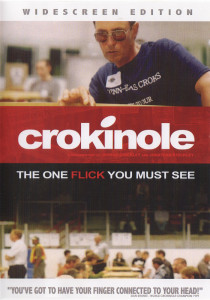 From that high point, the film slowly and pleasantly meanders. Crokinole lacks the narrative punch of other documentaries about competitive pastimes like Spellbound or Word Wars, but like them though, Crokinole is the authoritative documentary on its subject. While slow, the documentarians have covered all of their bases with the film, which captures multiple viewpoints on competitive crokinole. It’s also well-scored by the Earl Jones Trio. The film’s greatest strength though is its excellent tongue-in-cheek marketing, with the back cover stating “Those who have the adequate endurance to remain in a plastic chair for hours will excel, while those who cannot withstand the rigorous demands of a stationary position will falter.” This attitude towards crokinole seems to be widely shared by its Canadian players and the residents of Tavistock who all have a dry humor about the game and its championship tournament. “How could you miss it?” laughs one resident. A World Crokinole Championship referee sheepishly jokes about his neon safety vest, while another resident smiles and says of crokinole, “I wouldn’t say it’s nail-biting action like other sports, but yeah, it’s alright.” Gillies Lake Productions takes it further on the DVD cover and preemptively forewarns the would-be viewer with a quote from Bob Mader that “… It’s a long long grind.” Yes, yes, it is. While that statement isn’t misleading, the cover of the DVD is. On the copy I watched, the cover is dominated by the concentrating sunglassed Paul Stewart, an American player from Texas. It’s a decent image, but Stewart is in less than 2 of the movie’s 79 minutes. Most of the players are a great deal older and it would be more accurate to think of Crokinole as the Grumpy Old Men of gaming movies.
From that high point, the film slowly and pleasantly meanders. Crokinole lacks the narrative punch of other documentaries about competitive pastimes like Spellbound or Word Wars, but like them though, Crokinole is the authoritative documentary on its subject. While slow, the documentarians have covered all of their bases with the film, which captures multiple viewpoints on competitive crokinole. It’s also well-scored by the Earl Jones Trio. The film’s greatest strength though is its excellent tongue-in-cheek marketing, with the back cover stating “Those who have the adequate endurance to remain in a plastic chair for hours will excel, while those who cannot withstand the rigorous demands of a stationary position will falter.” This attitude towards crokinole seems to be widely shared by its Canadian players and the residents of Tavistock who all have a dry humor about the game and its championship tournament. “How could you miss it?” laughs one resident. A World Crokinole Championship referee sheepishly jokes about his neon safety vest, while another resident smiles and says of crokinole, “I wouldn’t say it’s nail-biting action like other sports, but yeah, it’s alright.” Gillies Lake Productions takes it further on the DVD cover and preemptively forewarns the would-be viewer with a quote from Bob Mader that “… It’s a long long grind.” Yes, yes, it is. While that statement isn’t misleading, the cover of the DVD is. On the copy I watched, the cover is dominated by the concentrating sunglassed Paul Stewart, an American player from Texas. It’s a decent image, but Stewart is in less than 2 of the movie’s 79 minutes. Most of the players are a great deal older and it would be more accurate to think of Crokinole as the Grumpy Old Men of gaming movies.
The Demographics of Crokinole
Fortunately for the viewer, the crokinole players that Crokinole introduces are all charming and congenial. They are also a very homogenous group, all white and predominately male. Two middle-aged or older women are also shown as part of the World Crokinole Committee. If Crokinole is sounding more and more like Cocoon, that’s not far off (though to be accurate, younger female players can be seen in the background of the World Championship footage). Brothers Jason and Raymond Bierling from “up country” are notable for both their red-hair and being “quite young” (someone thinks they are in their mid-20s) and while they appear in Crokinole, they are not the focus of the film. Nor is the similarly-aged, long-haired and bearded Birch Kuch from the Yukon who briefly makes an appearance in the championship.

Three Time World Crokinole Singles Champion Joe Fulop © Bill Gladding / Tavistock Gazette
The Champions
Instead, filmmakers Joshua and Jonathan Steckley focus on four subjects. Farmer Dan Shantz is a previous winner of the 2001 Doubles Crokinole Championship and got a lot of practice as a child when he was ill and housebound, playing each of his fingers against the others. Unfortunately Shantz doesn’t tell us whether his pinky beat out his index finger, but his anecdote speaks volumes about the amount of solo practice championship crokinole requires. Grandfather Bob Mader may or may not be a farmer, but he lives in or near a village, and won $500 for his third place finish in a World Crokinole Championship. Mader played for Canada in the 1962 World Ice Hockey Championships, but sustained a knee injury in the championship game against the USA. The film jacket humorously advises in the rating section that Crokinole contains Canadian accents, but Mader’s speech like many of the others who appear in the film is also quaint and charming. Ringing a bell on his home’s porch, Mader reminisces, “Give it a dingle, that was dinnertime.” Joe Fulop is a part-time teacher, golf enthusiast, and the 2001 & 2002 Crokinole Singles World Champion. Someone says of Fulop, “That’s what he has for breakfast: crokinole. For dinner: crokinole.” It’s probably accurate on some days, because Fulop does play a lot of crokinole against himself. One of the challenges facing Fulop is his escalating Parkinson’s disease. He manages some humor about it. When asked whether it’s the worst disease for a crokinole player, Fulop’s eyes twinkle as he responds, “Well, cancer’s worse.” Al Fuhr is the fourth subject and most athletic, playing on two baseball teams when not fishing or flicking crokinole discs. Comparing himself to the single Fulop, Fuhr points out about himself that he leads an active lifestyle, a lifestyle slightly crimped because of an accident involving a 500-pound shed door which fell on his head.
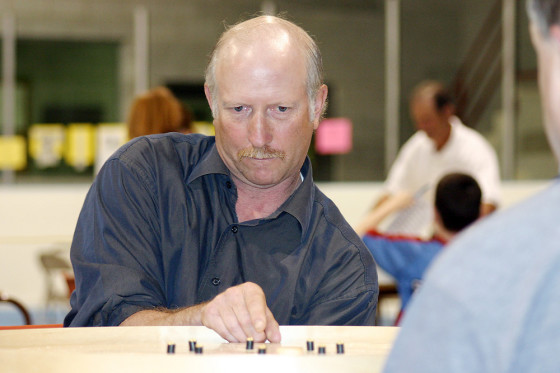
Crokinole Subject Al Fuhr Concentrating During the WCC © Bill Gladding / Tavistock Gazette
Mr. Crokinole and Other Crokinole Personalities
Besides the four players, the documentary focuses on Wayne Kelly, or as he is more famously known, Mr. Crokinole. Kelly runs crokinole.com and has spent a good deal of time documenting the game’s history, including the origins of the name crokinole, a difficult task given that he consulted “28 to 30” dictionaries and encyclopedias which lacked any mention of the Canadian board game. As an expert on the subject, Kelly provides the real backbone to the documentary and as one might expect, the documentary is also sold on crokinole.com. His inclusion in the documentary would seem to be mandatory. He authored The Crokinole Book which sold out of its first printing of 5,000 copies within the first year of publishing it in 1988, has had over 3,000 different crokinole and carom boards pass through his hands, and sells 5-8 crokinole boards each day.
The other subject that Crokinole frequently cuts back and forth to is Willard Martin as he constructs a crokinole board out of particle board in his workshop. Despite his hopes (and Mr. Crokinole’s) that various flubs will be edited out, they are instead preserved for the viewer to enjoy. Want to watch Martin clean his urethane brush? Joshua and Jonathan Steckley have also captured that. While most of his moments on camera could have been edited out, Willard Martin’s nostalgia as he recalls listening to the radio with his father as a child is quite touching and well worth including. Besides identifying him as Willard Martin though, the directors fail to point out Martin’s significance to crokinole. A quick Google search reveals that Willard Martin is indeed a second-generation crokinole board maker, selling his WILLARD boards through crokinolegame.ca. So great is his skill at board making that his boards have been used at the World Crokinole Championships.
The World Crokinole Committee
The World Crokinole Championships are hosted and organized by the World Crokinole Committee, as one might expect. It’s here, in showing the committee at work, that some of Crokinole’s most heated and dramatic moments can be found. Watch as a number of crokinole board storage boxes fall over! Listen as the committee discusses the “pro-cess” for paperwork. Board 46 is missing! Someone may have taken one of the boards to get some illegal practice in! Sadly, the investigation into the missing board is stopped once it is located. It’s because of scenes like this, the Canadian accents, and the film’s many other ironies that Crokinole also feels like an extended episode of Kids in the Hall from time to time and occasionally made me wonder whether Crokinole is a mockumentary or not. If it is, the humor is so slight and its treatment of its subjects so gentle that it barely registers as such, besides being non-fictional.
No Slam Dunks in Crokinole: The Crokinole World Championship
Just like children and beginners getting strikes in bowling, it is quite possible for newbies to get a 20 in crokinole. Scoring a 20 while also knocking your opponent’s piece into the gutter is even fancier, but there’s no equivalent to slam dunking in crokinole. There’s nothing the “masters” of the game can do that a player at home cannot. Because of this much of the World Crokinole Championship is uninspiring to watch. For about five minutes in Crokinole though, the flicking is fast and furious as 20 after 20 is scored by Joe Fulop and Al Fuhr in the semi-finals. It only escalates from there in the championship as stony-faced Joe Fulop battles the much younger Brian Cook. “The third time is the sweetest,” Fulop says after his victory.
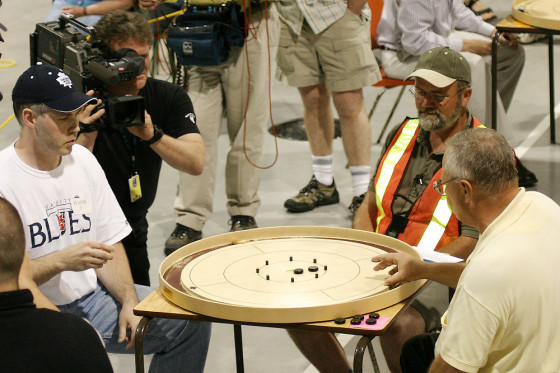
2004 World Crokinole Championship: Cook vs. Fulop © Bill Gladding / Tavistock Gazette
Strategy in Crokinole?
While the champion and runner-up certainly exhibit great skill, a different moment in Crokinole had me shaking my head. When asked about Al Fuhr and how his crokinole playing compares to his baseball playing, his baseball coach Tom Myers, says “He’s extremely competitive, regardless of which he’s playing and strategic. I mean, crokinole, he’s thinking three plays ahead and in the ball diamond, he’s the same. He’s thinking two or three batters ahead, where I should be putting it on the plate. So [he’s] strategic in both too.” Now unless I’m missing something huge about the game of crokinole, it seems that the goal and strategy never vary: score as many points as you can and prevent your opponent from doing so. Just like picking up a split spare in bowling or playing darts, playing well requires finesse and a lot of practice, but there is no change in strategy.
The Whole Crokinole… Almost
Despite the Steckleys’ thoroughness in documenting the many foibles of crokinole and mining the game’s depths for any humor, the directors missed the easy laugh that is “the one-cheek rule”, instead only covering it in the DVD’s special features. According to the one-cheek rule, crokinole players must keep one butt cheek on the chair at all times. This restricts players’ movements while at the same time preventing any tables from getting flipped. As a reaction to the one-cheek rule, crokinole is sometimes played on a rotating Lazy Susan to aid players in getting that perfect shot. The directors do include crokinole played with cue sticks (which is also a part of the World Crokinole Championships), but it would have been interesting to see or hear about any violations of the one-cheek rule or players’ opinions on rotating crokinole boards. They also include such crokinole slang as a “doogie”, which should never be confused with the “dougie” dance. A doogie is a 20 in the regional slang of Tavistock, Ontario. There is more humor as doogie is misidentified as the German word for twenty (zwanzig).
Photos of Joe Fulop, Al Fuhr, and Championship Match between Brian Cook and Joe Fulop © Bill Gladding / Tavistock Gazette and used with permission and many thanks.
